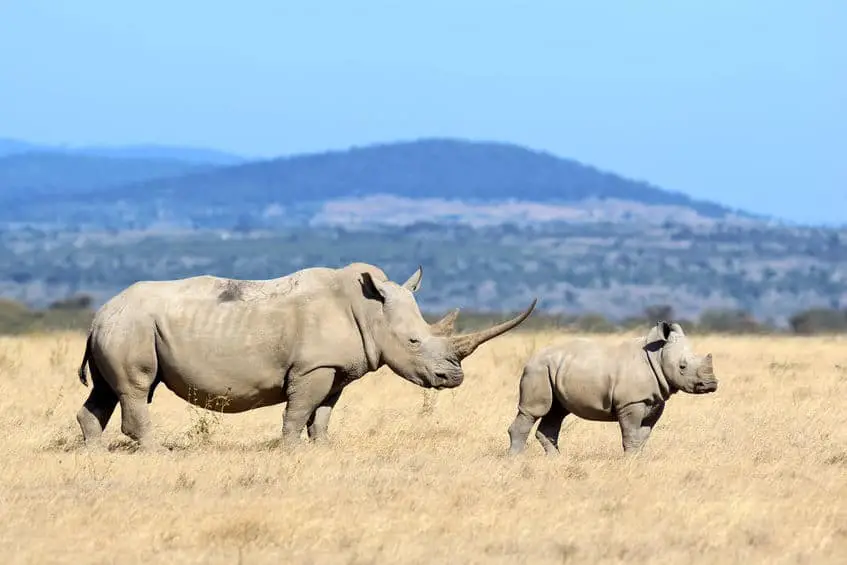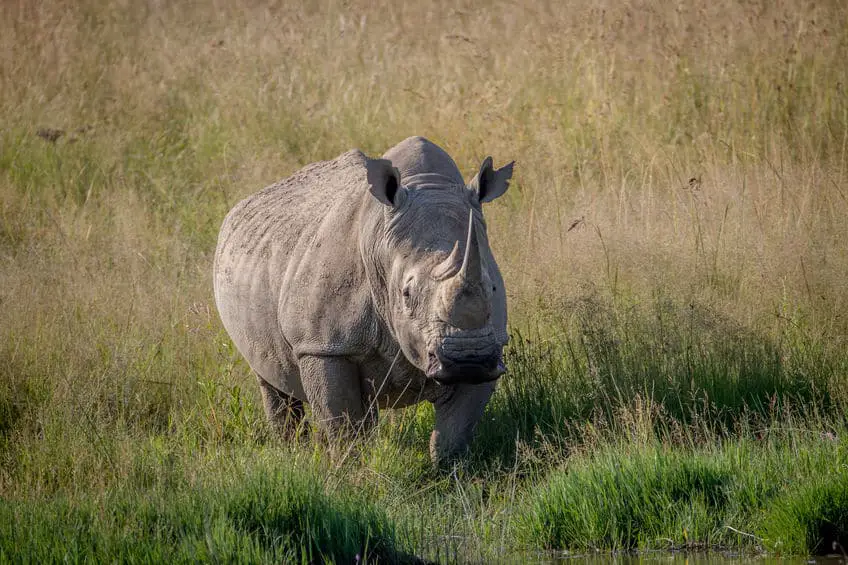
Two of the largest living land mammals are the two types of African rhinoceros: Black rhinoceros and white rhinoceros. But there is actually a surprisingly large difference in the size of these two types of rhinos. I have done some research and written this post about how large the two types of African rhinos are at different stages of their life.
White rhinoceros males weigh from 2000-3600 kg. The females weigh from 1400-2000 kg. White rhinoceros measure up to 1.80 meters at the shoulders. Black rhinoceros are significantly smaller and weigh from 700-1400 kg. and measure 1.40-1.80 meters at the shoulders.
African Rhinos are in many ways the animal kingdom’s version of the tank with its skin being as thick as 20 mm on the shoulders and 50 mm on the forehead. But other than the thick skin, the African rhinos, especially the white rhinoceros, can reach impressive sizes and weights.

White Rhinoceros. As Heavy as an Elephant
That’s right. This giant beast can grow to be as heavy as a fully grown female or a young male African elephant. Or as much as two average-sized cars. Or 45 grown men. Or… I could go in. It’s big is what I am trying to say.
The white rhinoceros is actually the largest of the five types of rhinos in the world.
But let us back up for just a bit.
After a 16-month pregnancy, the female white rhino gives birth to a calf. For the first couple of years, this calf stays with its mother but when the mother gives birth to another calf, which usually happens after 2-3 years, the first calf is abandoned and seeks company, either by finding other young rhinos or another female with no calf of its own.
At birth, the white rhinoceros calf weighs 40-65 kg. but will grow and increase its mass and weight quickly, gaining about 1.25 kg. per day.
After birth, it takes around five weeks before the white rhino calfs’ very characteristic horn starts to grow. When the white rhino is young, its horn can grow up to as much as 6 cm per year. In old white rhinos, the horn grows around 3 cm per year, about half of the young ones.
The males get the strongest horns but the females get the longest.
The longest horn from an African white rhinoceros ever on record measures an impressive 158 cm.
When the male white rhinoceros is fully grown, it weighs between 2000-3600 kg. As much as a female African elephant.
A fully grown female white rhinoceros weighs a fair bit less than the male but is still well into the four digits. They weigh between 1400-2000 kg.
White rhino males measure 3.7-4 meters in length and females measure 3.4-3.6 meters in length. Fully grown white rhinos measure up to 1.80 meters at their shoulders.
The lifespan of white rhinoceros is between 40-50 years.
Now that we have learned some things about the size of the white rhinoceros at different stages of their lives, let us take a look at the black rhinoceros.

Black Rhinoceros. Small But Aggressive
While the white rhinoceros is also endangered, the black rhinoceros is unfortunately even more so. It is categorized as being critically endangered, in large due to poaching and loss of habitat.
The black rhinoceros is significantly smaller than the white rhinoceros but what it lacks in size, it certainly does not lack in temper. This rhino might be small but it is known to be much more aggressive than the white one.
More fights occur between black rhinos than between white rhinos and black rhinos are also more likely to show aggression towards humans and cars.
Let us take a look at how large the black rhino is.
After being pregnant for 14-15,5 months, the female black rhino gives birth to a calf. Like the white rhino, the black rhino gives birth to just one calf at a time.
At birth, the black rhinoceros calf weighs 30-45 kg.
When fully grown, the black rhinoceros measures 2.8-3.8 meters in length and weighs 700-1400 kg. About half of the white rhino.
The black rhinoceros measures between 1.4-1.8 meters in height.
The expected lifespan of a black rhinoceros is 35-50 years.
Two Armored Giants
So as you can see, both the black and the white rhinoceros are very large animals but the white rhinoceros is, however, a quite significant bit larger than the black rhino as it weighs just about twice as much.
Some Other Differences Between Black and White Rhinos
As we have just learned, the two types of rhinos are very different in size but there are also several other interesting differences between the two types of African rhinos.
Ironically, the colors or the rhino is not a very good way to determine whether you are looking at a black or white rhino. They are both grey and the shade of grey mostly depends on the mud and dust, the individual rhino has been rolling around in.
One of the best ways to determine if you are looking at a black or a white rhino is to look at its mouth.
White rhinos have a 20-30 cm wide mouth. The fact that the mouth is flat and wide makes it extremely useful and efficient when it comes to picking and eating grass which is the white rhinoceros primary food.
The black rhino’s mouth and snout look very different than those of the white rhino. It is pointy and designed for picking leaves, branches, and other things.
The black rhino has a smaller head than the white rhino and the shape is also slightly different with the black rhino having a shorter head and the white a longer head with a less defined forehead than the black one.
Since we’re already on the subject of their heads, let us take a look at the ears. The black rhino has smaller and rounder ears than the white ones whose ears are longer and more pointy.
So there you have a couple of things to look for when trying to determine which of the two types of rhinos you have spotted.
Where to See Rhinoceros in Africa
There are two subspecies of white rhinoceros in Africa. The northern white rhinoceros and the southern white rhinoceros. The southern subspecies is categorized as “Near Threatened” and the northern as “Critically Endangered” so they are both rare but more common in the south.
The white rhinoceros can be seen in South Africa, Namibia, Zimbabwe, Kenya, and Uganda. It mostly stays in open savannas since these provide the grass that makes up the majority of the food for the white rhinoceros.
The black rhinoceros is categorized as critically endangered and is a very rare sight. They used to be widely distributed south of Sahara but are now almost only found in protected areas such as national parks.
Most black rhinos are found in South Africa, Namibia, Kenya, and Zimbabwe.
I myself have never been fortunate enough to see a black rhinoceros in Africa but I have had plenty of luck with the white ones.
The first time I saw white rhinos in the wild was in the Etosha National Park in the northern part of Namibia. Since then, I have visited Kruger National Park in South Africa where I have seen many of them, especially in the southern and central parts of the park.

